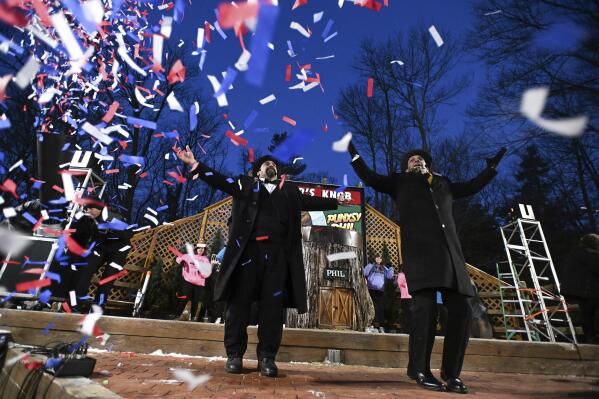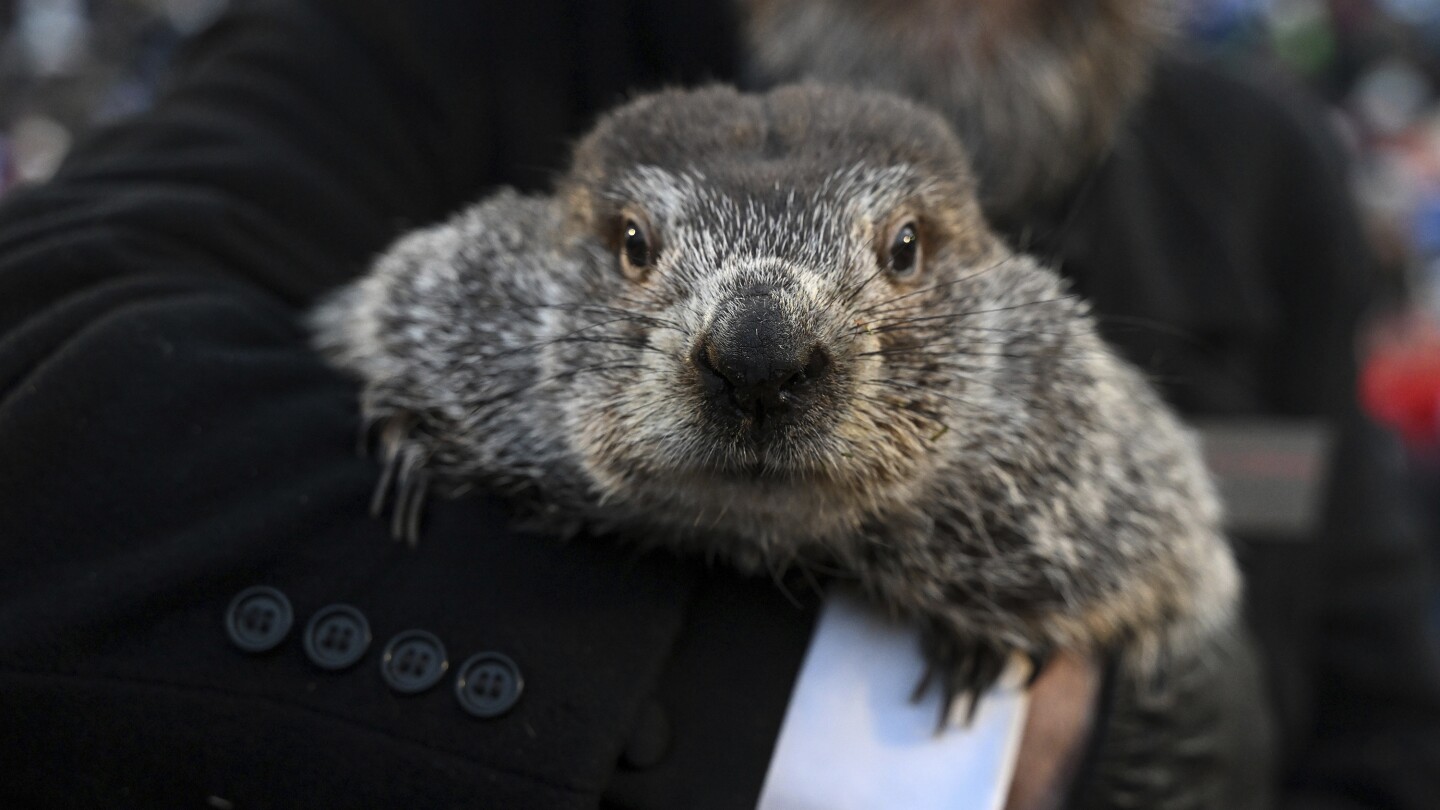Last Updated: February 02, 2024 07:37 AM
Published: February 02, 2024 05:00 AM
Punxsutawney Phil didn’t see his shadow in a ceremony this morning Gobbler’s Knob in Western Pennsylvania. Per tradition, that means an early spring.
Here’s what we’re covering:
- Phil’s fellow prognosticators: Don’t like Phil’s prediction? Check out the predictions from ‘Bee Cave Bob,’ ‘Staten Island Chuck,’ and a host of other critters across the U.S.
- Groundhog Day’s origins: It’s part of a tradition rooted in European agricultural life. But the science behind it is questionable at best.
- The (actual) weather report: It’s partly cloudy in Punxsutawney today as a particularly cold winter drags on. Big storms claimed at least 72 lives around the U.S. in January.
JUST IN: Punxsutawney Phil predicts an early spring
The Groundhog Day star didn’t see his shadow, according to the inner circle at Gobbler’s Knob.
Per tradition, that means an early spring.
Stand by for Phil’s forecast
More than a dozen men in top hats have taken the stage in Pennsylvania, where Groundhog Day star Punxsutawney Phil is waiting to make his prediction.
The weather is overcast and the sun still hasn’t quite made its way up.
Yep, some people eat groundhogs
Groundhogs are herbivores that are themselves edible to humans, although they are not widely consumed.
The Pennsylvania Game Commission says about 36,000 hunters reported killing more than 200,000 groundhogs last year.
Game Commission spokesperson Travis Lau found groundhog a bit stinky to clean and thick-skinned, but “actually really good” and “more like beef than venison.”
“The whole family ate it and liked it, and everybody had apprehensions,” Lau said.
Some cooks advise groundhogs are best taken when they are young and after clover is in bloom, since a clover diet is thought to improve the meat’s taste.
Remembering a 2014 Groundhog Day tragedy
In New York City, Staten Island Chuck will make his prognostication about whether there will be an early spring on the 10th anniversary of a notorious incident that roiled the city.
It was on Groundhog Day 2014 that a predecessor of the Staten Island Zoo’s furry critter wriggled out of the hands of then-Mayor Bill de Blasio during the ceremony and fell to the ground. It died a week later.

FILE – In this Feb. 2, 2014 image made from video, a groundhog breaks free from New York Mayor Bill de Blasio, left, and drops to the stage during the 2014 Groundhog Day ceremony at the Staten Island Zoo, in New York. (AP Photo/Staten Island Advance, Anthony DePrimo)
An autopsy revealed it suffered internal injuries, but it was not clear if they stemmed from the fall.
And it wasn’t the first disastrous run-in between Chuck and a mayor. In 2009, Chuck bit through then-Mayor Michael Bloomberg’s glove, chomped on his left index finger and drew blood.
After the de Blasio debacle, zoo officials instituted new safety measures that remain in place today. Chuck is protected in a Plexiglas enclosure during the ritual, and no one is allowed to hold him except zoo handlers.
The zoo said Thursday that it hadn’t received a response from Mayor Eric Adams about whether he will attend this year’s ceremony.
Like Groundhog Day? Consider joining a club

Groundhog Club Groundhog Club Vice President Dan McGinley (right) and Dave Gigliotti entertain the crowd while waiting for Punxsutawney Phil during the 137th celebration of Groundhog Day on Thursday, Feb. 2, 2023. (AP Photo/Barry Reeger)
Groundhog lodges started opening in eastern Pennsylvania in the 1930s.
They were social clubs with similarities to Freemasonry, intended to preserve Pennsylvania German culture and traditions. Clubs would sometimes fine those who were caught speaking anything but their Pennsylvania Dutch language at meetings.
They were traditionally all-male groups and 15 such clubs remain active.
“I think it’s just one of these traditional rituals that people enjoy participating in, that maybe take them away from modern life for 15 minutes,” said William W. Donner, a Kutztown University anthropology professor and author of “Serious Nonsense,” a book about such lodges and other efforts to preserve German heritage.
The sun isn’t even up yet, but Phil’s party already is well underway in Pennsylvania
A bundled-up crowd, some wearing groundhog-themed hats, watched musical performances and fireworks as they waited for sunrise and the appearance of Punxsutawney Phil.
Pennsylvania Gov. Josh Shapiro took the stage Friday morning to urge people around the world watching the festivities to come to Punxsutawney next year. And Shapiro announced that Phil is the new official state meteorologist for Pennsylvania.
“Punxsutawney is the center of the universe right now and I love that you’re all here,” Shapiro said.
‘Absolutely destitute of any interesting qualities’: New Hampshire’s beef with groundhogs, explained
Far from celebrating groundhogs, New Hampshire once tried to eradicate them from the state via a short-lived but wildly successful bounty on their pelts.
The state paid $12,206 in groundhog bounty claims for the fiscal year ending June 1885. At 10 cents per pelt, that amounted to more than 120,000 groundhogs — or woodchucks, as they were called then.
The bounty, which was repealed soon after, was the result of a legislative committee appointed to study the critters. Their view was decidedly negative.
Declaring the animals “not only a nuisance, but also a bore,” state Rep. Charles Corning called them “absolutely destitute of any interesting qualities” and “one of the worst enemies ever known to the farmer” in his 1883 “Report of the Woodchuck Committee.
“In some parts of the state it is found necessary to shovel a path through the woodchucks in order to reach the barns,” he added. “This is not right.”
The current groundhog population in New Hampshire is unknown, though they remain a frequent problem for gardeners, according to the University of New Hampshire Cooperative Extension.
Its experts don’t recommend killing them, however, noting that their burrows provide shelter for other animals. Instead, officials recommend fencing as a way to keep them from devouring veggies.
Texans will be looking to ‘Bee Cave Bob’ for their prediction
A couple hundred people are expected to gather Friday afternoon in Bee Cave, located just west of Austin, to watch an armadillo named Bee Cave Bob.
Mike Burke, who helped start the annual tradition, believes an armadillo “knows a whole lot more about what’s going on than some rodent.”
“You won’t see any top hats or tails when we do our armadillo deal. You might see some cowboy hats and Wrangler jeans,” Burke said.
Their ceremony also includes watching to see if the animal sees his shadow, but they aren’t opposed to improvising a little to make sure the crowd goes home happy.
“A lot of the times when it’s been kind of a crummy winter, we’ll predict early spring no matter what,” he said.
West Virginia’s furry prognosticator was in. Then he was out. Now he’s in again
French Creek Freddie is back to make his annual Groundhog Day forecast at the West Virginia State Wildlife Center. But it almost didn’t happen.
Groundhog Day forecasts have been held at the center for four decades. On Wednesday, Gov. Jim Justice said the U.S. Department of Agriculture would no longer recognize a longstanding variance for a secondary containment fence.
That meant the center would be unable to exhibit animals and would be closed until a new license was issued.
But, the USDA issued a one-day clearance for Friday’s ceremony.
GOOD NEWS: After speaking with @USDA Secretary Tom Vilsack yesterday on the importance of French Creek Freddie’s Groundhog Day in WV, I have been assured that French Creek Freddie will have the opportunity to look for his shadow tomorrow morning. MORE: https://t.co/bhvITgUO5i
— Senator Joe Manchin (@Sen_JoeManchin) February 1, 2024
Phil’s accuracy rate is only 40%, according to the NOAA
Some well-meaning efforts have sought to determine Phil’s accuracy, but what “six weeks of winter” means is debatable. By all accounts, the furry prognosticator predicts more winter far more often than he predicts an early spring.
And claims that a groundhog has or has not seen its shadow — and that it’s able to communicate that to a human — are also fair territory for skeptics and the humor impaired.
Among the skeptics is the National Centers for Environmental Information, within the National Oceanic and Atmospheric Administration. The government agency last year compared Phil’s record with U.S. national temperatures over the prior decade and concluded he was right only 40% of the time.
The Bill Murray effect
The 1993 Bill Murray movie, “Groundhog Day” caused such a resurgence of interest in Punxsutawney that two years after it came out, event organizers voiced concern about rowdy crowds drinking all night, people climbing trees and others stripping to their underwear.
In 1998, a groundhog club leader wearing a $4,000 groundhog suit reported being assaulted by a half-dozen young men.
Alcohol is now prohibited at Phil’s spot in Gobbler’s Knob.
Why Punxsutawney?
Punxsutawney is an area that Pennsylvania Germans settled — and in the late 1880s started celebrating the holiday by picnicking, hunting and eating groundhogs.
Members of Punxsutawney Groundhog Club, organized in 1899, care for Phil at a customized space beside Punxsutawney Memorial Library — where there’s a window with a view into the creature’s burrow.
It was badgers or bears before it became groundhogs
Mr. Groundhog relaxes in his bed, Feb. 3, 1959, in Scranton, Pa., after making his prediction. (AP Photo, File)
Ancient people would watch the sun, stars and animal behavior to guide farming practices and other decisions, and the practice of watching an animal’s emergence from winter hibernation to forecast weather has roots in a similar German tradition involving badgers or bears.
Pennsylvania Germans apparently substituted the groundhog, endemic to the eastern and midwestern United States.
Historians have found a reference in an 1841 diary to groundhog weather forecasts in early February among families of German descent in Morgantown, Pennsylvania.
Why is Groundhog Day celebrated on Feb. 2?
It’s part of a tradition rooted in European agricultural life, marking the midpoint between the shortest day of the year on the winter solstice and the spring equinox.
What the Celts called Imbolc is also around when Christians celebrate Candlemas, timed to Joseph and Mary’s presentation of Jesus at the Temple in Jerusalem.
Meet the ‘grundsau’ — a little critter with questionable forecasting skills
The groundhog is a member of the squirrel family and related to chipmunks and prairie dogs. It’s also known as a woodchuck, a whistle pig — or in the parlance of Pennsylvania Dutch, a language with German roots, a “grundsau.”
Their lifespan in the wild is typically two or three years, and they’re mostly solitary creatures who start to emerge in midwinter to find a mate.
The science behind whether they can make any accurate weather predictions is problematic at best.


